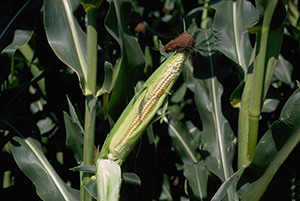Photo Credit: Howard F. Schwartz, Colorado State University, Bugwood.org. Creative Commons Attribution 3.0 License, http://creativecommons.org/licenses/by/3.0/us/.
Zea mays
Common Name: corn
Plant Functional Group: Graminoid
Class > Order > Family: Magnoliopsida > Poales > Poaceae
Where is the species found?
States & Provinces
AL, AR, AZ, CA, CO, CT, FL, GA, IA, ID, IL, IN, KS, KY, LA, MA, MD, ME, MI, MN, MO, MS, MT, NC, NE, NH, NJ, NM, NV, NY, OH, ON, OR, PA, PR, QC, RI, SC, TN, TX, UT, VA, VI, VT, WA, WI, WV, WY
Which phenophases should I observe?
Do you see...?
Leaves
Initial growth More...
Leaves More...
What percentage of the plant is green?
Less than 5% 5-24% 25-49% 50-74% 75-94% 95% or more
Flowers
Flower heads Zea mays , the male inflorescence is the "tassel" which is initially compact, but eventually elongates and becomes plume-like and waves loosely at the top of the plant. The female inflorescence is the "ear" which includes the long, leafy bracts (the "husk") that cover and hide the flowers lined up in rows on the "cob". The stigmas of each individual flower grow long and extend out at the top of the husk (the "silk"). Once the female flowers are fertilized, the "ear" grows in size as the fruits develop.More...
How many fresh flower heads are present?
Less than 3 3 to 10 11 to 100 101 to 1,000 More than 1,000
Open flowers Zea mays , the male flowers will open once the initially compact plume has elongated and is waving loosely. Female flowers are open when the stigmas are visible, that is, the first "silk" emerges from the top of the "husk".More...
What percentage of all fresh flowers (unopened plus open) on the plant are open?
Less than 5% 5-24% 25-49% 50-74% 75-94% 95% or more
Pollen release More...
How much pollen is released?
Little: Only a few grains are released. Some: Many grains are released. Lots: A layer of pollen covers your palm, or a cloud of pollen can be seen in the air when the wind blows
Fruits
Fruits Zea mays , the fruit is a small grain ("kernel"), tightly arranged in rows that surround a thick cylindrical stem (the "cob") and are hidden under large, long bracts (the "husk"), and changes color from white or cream to its appropriate ripened varietal color (which may be yellow, red, purple, or blue) and in texture from soft or watery to firm or hard, depending on its appropriate ripened varietal characteristics.More...
How many fruits are present?
Less than 3 3 to 10 11 to 100 101 to 1,000 More than 1,000
Ripe fruits Zea mays , a fruit is considered ripe when the grain has matured to its appropriate ripened varietal characteristics.More...
What percentage of all fruits (unripe plus ripe) on the plant are ripe?
Less than 5% 5-24% 25-49% 50-74% 75-94% 95% or more
Recent fruit or seed drop More...
How many mature fruits have dropped seeds or have completely dropped or been removed from the plant since your last visit?
Less than 3 3 to 10 11 to 100 101 to 1,000 More than 1,000
What do these phenophases look like?
There is currently no photoguide available for this species. If you'd like help us create one, use the guidance document and species template provided here . Then send it via email to education@usanpn.org when it is complete.
